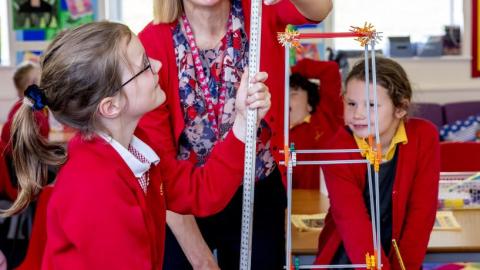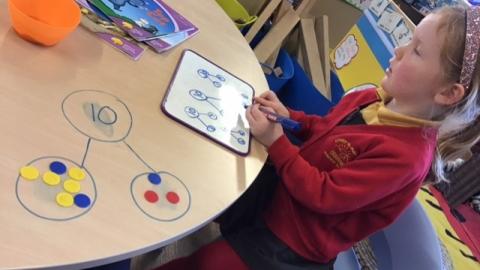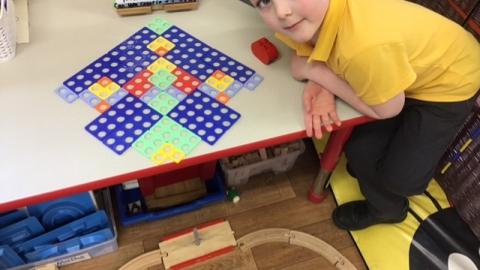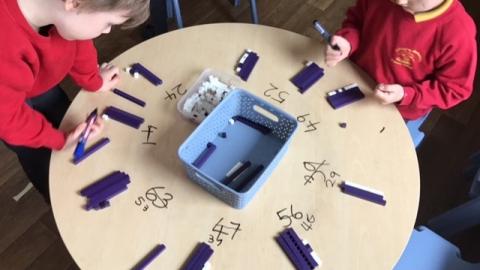Mathematics is a creative and highly inter-connected discipline that has been developed over centuries, providing the solution to some of history’s most intriguing problems. It is essential to everyday life, critical to science, technology and engineering, and necessary for financial literacy and most forms of employment. A high-quality mathematics education therefore provides a foundation for understanding the world, the ability to reason mathematically, an appreciation of the beauty and power of mathematics, and a sense of enjoyment and curiosity about the subject.
Implementation
To ensure whole-school consistency and progression, Mathematics is planned and sequenced using a combination of Mastering Number and White Rose in the EYFS and KS1, and the use of White Rose small step progression is continued into KS2. This is fully aligned with the National Curriculum.
In EYFS, KS1 and KS2, maths challenges are presented with objects (concrete manipulatives) and pictorial representations. Lessons focus on both conceptual and procedural knowledge and the large majority of children progress through the curriculum content at the same pace.
Differentiation is achieved by emphasising deep knowledge and through individual support and intervention. Mathematical topics are taught in blocks, to enable the achievement of ‘mastery’ over time.
Practice and consolidation play a central role. Carefully designed variation within this builds fluency and understanding of underlying mathematical concepts. Every class from Year 1 upwards do regular spaced retrieval through 'Flashbacks' to help them recap and retain knowledge.
Mathematics Planning
Our calculation policy includes CPA (concrete, pictorial, abstract) strategies, as well as a 'Thinking CAPS' document that gives a really clear overview of the progression in calculation and problem solving. This is a document we can use to accompany the White Rose planning. We used the DfE Ready to Progress criteria to ensure key concepts have been mastered post COVID and continue to use these as our broad 'end points' we expect children to achieve by the end of each year.
Also see Mathematics and Calculation Policy attachments below.
Whole class together – we teach mathematics to whole classes and do not label children (this includes within the classroom). Lessons are planned based on formative assessment of what students already know and we include all children in learning mathematical concepts. At the planning stage, teachers consider what scaffolding may be required for children who may struggle to grasp concepts in the lesson and suitable challenge questions/activities/open-ended investigations for those who may grasp the concepts rapidly. Decisions are not made about who these children may be prior to the lesson.
Longer and but deeper – in order to address the aims of the NC, our long/medium term plans have been adjusted to allow longer on topics. Each lesson focus is on one key conceptual idea and connections are made across mathematical topics. To outsiders it may appear that the pace of the lesson is slower, but progress and understanding is enhanced. Our assessment procedures recognise that the aims of the curriculum cannot be assessed through coverage (ticking many objectives off a list) but through depth within a topic. We use daily flashbacks, regular mental maths sessions and WR end of block assessments to identify any gaps and to aid knowledge retrieval and retention. We follow the White Rose Scheme of Work and use PUMA Assessments that are fully aligned to White Rose.
Key learning points are identified during and a clear journey through the maths is shown (with examples, key vocab/stem sentences and top tips on working walls). Concrete resources and pictorial images are used to unpick the mathematical structures and relationships and challenge learning. Questions will probe pupil understanding throughout. ‘Tricky bits’ are identified during the planning process and children will be supported through these.
Fluency – We recognise that ‘fluency’ is not just about remembering facts and develop all aspects of fluency through lessons; additional practice is given when children need more time to become more fluent in a particular area. We aim to automaticity with procedures and key knowledge to reduce cognitive overload. Please also see our Progression of Number Fact Fluency and Times Tables document that summarises the knowledge learnt through the Mastering Number sessions in EYFS and KS1, continuing into times table knowledge to be learnt throughout KS2.
Developing reasoning and deep understanding (contexts and representations of mathematics) – problems are usually set in real life contexts - carefully chosen representations (manipulatives and images) are used by all to explore concepts. The use of practical resources, pictorial representations and recording takes place in most lessons (the CPA approach)if and when it helps to show the mathematical structures. This may be seen on flipcharts, displays, on tables and/or in books.
Structuring - the teacher will organise the findings of the exploration, compare/contrast strategies and guide toward the most efficient strategy (or the one being learnt that day).
Step by step approach – journey through the mathematics (these steps may appear small, especially at the beginning of a lesson, there are points when suddenly a jump appears to have been made, or an extra challenge appears – this is normal). Teachers’ flipcharts will clearly show this step by step approach.
Questions to challenge thinking – teachers use questioning throughout every lesson to check understanding – a variety of questions are used, but you will hear the same ones being repeated; How do you know? Can you prove it? Are you sure? Is that right? ‘What’s the value? What’s the same/different about? Can you explain that? What does your partner think? Can you imagine? Can you persuade others? Can you give me another example? How many possibilities?
Questions are also used to challenge children who have grasped the concept. Children are expected to listen to each other’s responses and may be asked to explain someone else’s ideas in their own words, or if they agree/disagree etc.
At times, children may record work during the teaching input. At times, this will be an independent task, depending on concept being taught. The recording that does take place however, shows greater depth of understanding and intelligent practice. We do not want children to attempt independent recording until we believe they are secure with the concept.
Discussion and feedback – pupils have opportunities to talk to their partners and explain/clarify their thinking throughout the lesson, but are expected to complete written work independently (unless working in a guided group with the teacher).
Rapid intervention (same day/next day catch up) – in mathematics new learning is built upon previous understanding, so in order for learning to progress and to keep the class together pupils need to be supported to keep up and areas of difficulty must be dealt with as and when they occur.
Marking – the marking policy follows the NCETM guidelines published April 2016. The policy requires that learning is ticked and a comment is only made if/when a teacher feels this is necessary to move learning forward. Gap tasks may appear for individual children in their books, but usually gaps are addressed through same day/next day catch up and therefore will not necessarily be recorded in books. The most valuable feedback is given during a lesson. Children are encouraged to self/peer assess and will often self mark/correct where able to do so.
Planning – teachers plan using White Rose materials and adapt by thinking about lesson structure, small steps, variation and the sequence of a lesson and to plan for when it is beneficial to work with concrete and pictorial resources. Lessons may incorporate multiple year groups but teachers are aware of year expectations and follow plans which have structured progression.
SEN pupils – may be supported by additional adults or different resources. They may also complete additional activities outside of the mathematics lesson. Ways to support these pupils are highlighted purple. Maths packs are available in every class with additional resources such as multiplication squares, etc. We have a whole school document which serves as a reminder to all staff as to best practice for supporting pupils who have special needs. We have high expectations of all children and strongly believe that all children are equally able in mathematics. Some may take longer to grasp concepts and may need careful scaffolding or extra time/support but they can still achieve!
Assessment and Knowledge Retention–PUMA assessments aligned to White Rose are used to give a maths age and a standardised score and this is uploaded to FFT which converts this to a scaled score, enabling us to closely track progress against pupils FFT 20 scaled score targets. Teacher assessment is shown through marking and end of block WR tasks in pupil books. We use daily flashbacks, regular mental maths sessions/quizzes and end of block assessments to check gaps and aid knowledge retrieval and retention.
Impact
As well as assessment for learning during lessons, regular and ongoing assessment of the pupils’ outcomes informs teaching, as well as intervention, to support and enable the success of each child.
We use a variety of strategies to evaluate the knowledge, skills and understanding that our children gain as they progress from Nursery to Year 6:
- Regular feedback marking and pupil voice feedback
- Subject monitoring, including planning scrutinies, book looks and learning walks
- Regular low stakes knowledge assessments, using WR end of block tasks and flashbacks
- Termly PUMA tests to support our teachers’ assessment
These factors help us to maintain high expectations and high standards in Mathematics, with achievement at the end of KS2 normally in line with the national average and an increasingly higher proportion of children demonstrating greater depth, at the end of each phase.




